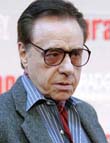 Peter Bogdanovich, in the wised-up but morally clueless view of the international showbiz media, is generally seen as a figure from the California branch of modern Greek tragedy, where early hubris is punished first by nemesis and then by oblivion, in the form of the lecture circuit and guest appearances on daytime talk shows. The facts would be to the contrary even if Bogdanovich, in later life, had not made several films which at least match the standard of those in his early winning streak from The Last Picture Show onwards. And if he had never made any movies in the whole of his life he would still be one of the important modern writers on film, although his kind of criticism – always knowledgeable about the business background – is rarely written except by practitioners: one of his many connections with the French New Wave directors who wrote articles about film before they made films. Much of Bogdanovich’s best writing about the art he personifies shows up in his first book Pieces of Time (1973), written out of the same sense of discovery and urge to preserve which made him the foundation-laying film curator of the Museum of Modern Art in New York. His long catalogue essays for his MOMA seasons were, effectively, his first books, and Pieces of Time can be thought of as their epitome. His later, bigger books (Who the Devil Made It? and Who the Hell’s In It?) are considerable – my National Film Theatre interview with him, included here, was occasioned by the publication of one of them – but they are not, I think, the place to start for anyone who wants to understand him fully as the force he was and still is in the Hollywood that counts.
Peter Bogdanovich, in the wised-up but morally clueless view of the international showbiz media, is generally seen as a figure from the California branch of modern Greek tragedy, where early hubris is punished first by nemesis and then by oblivion, in the form of the lecture circuit and guest appearances on daytime talk shows. The facts would be to the contrary even if Bogdanovich, in later life, had not made several films which at least match the standard of those in his early winning streak from The Last Picture Show onwards. And if he had never made any movies in the whole of his life he would still be one of the important modern writers on film, although his kind of criticism – always knowledgeable about the business background – is rarely written except by practitioners: one of his many connections with the French New Wave directors who wrote articles about film before they made films. Much of Bogdanovich’s best writing about the art he personifies shows up in his first book Pieces of Time (1973), written out of the same sense of discovery and urge to preserve which made him the foundation-laying film curator of the Museum of Modern Art in New York. His long catalogue essays for his MOMA seasons were, effectively, his first books, and Pieces of Time can be thought of as their epitome. His later, bigger books (Who the Devil Made It? and Who the Hell’s In It?) are considerable – my National Film Theatre interview with him, included here, was occasioned by the publication of one of them – but they are not, I think, the place to start for anyone who wants to understand him fully as the force he was and still is in the Hollywood that counts.
In a New Yorker article about Bogdanovich I raised the issue of Dorothy Stratton and how he dealt with the catastrophe of her violent disappearance from his life. It was a sensitive issue but he didn’t cancel our next lunch date, where he was as funny as ever, wielding as he does a generous but wicked gift for mimicry, and commanding a rich field of showbiz reminiscence in which it can operate unchecked. It should never have been news to the journalists, but it still needs to be said: the reason What’s Up Doc? came so close to reproducing the pristine thrill of classic screwball comedy was that its director had a brilliant sense of humour. My task here has been to present, in a small space, a sufficiently faithful picture of a man who has spent his life showing how creativity and critical appreciation can share the same soul.
Click here to read a transcript of my interview with Peter Bogdanovich at the National Film Theatre (London, 2004), published in the Guardian.
See also these YouTube videos of the director speaking:
Bogdanovich on Bogdanovich, a seven-minute excerpt from a masterclass.
Instinctual Artistry, a two-minute excerpt from his 2007 New York Film Festival press conference.